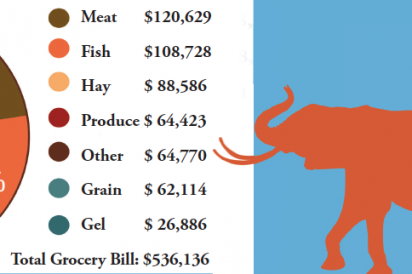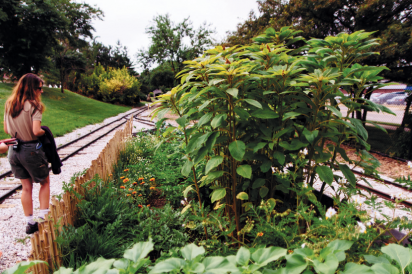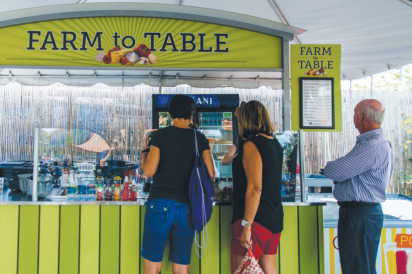Feasts for the Beasts
The mission of the Indianapolis Zoo is to empower people and communities, both locally and globally, to advance animal conservation. The original Indianapolis Zoo opened in 1964 and in the summer of 1988 moved to its current location at White River State Park. Over $1.98 million was raised this year at the 28th annual Zoobilation fundraiser, where over 70 local restaurants provide food and beverages to a sold-out black-tie crowd. U.S. News & World Report ranked the Indianapolis Zoo as No. 6 on its list of Things to Do in Indianapolis.
Edible Indy asked: How does the zoo support the local food movement with the animals? The answers might surprise you.
Indianapolis Zoo feeds and cares over 2,000 animals (230 species) and 16,000 plants.
2013 GROCERY BILL
(Approximately 50% of the groceries are purchased locally.)
Hay
300 tons (600,000 pounds) of grass and alfalfa hay are locally grown, harvested and purchased each year.
“The zoo recently established a purchasing agreement with the Indianapolis Airport Authority to procure hay from the land that surrounds the airport. According to the FAA this property must remain ‘empty’ but it can be cultivated for crops such as grass/ alfalfa, wheat and certain legumes. By entering into this agreement we are establishing relationships with local farmers and supporting the local economy,” says Zoo Nutritionist Jason Williams, PhD.
$90,000—$105,000 in hay is purchased locally each year from two vendors.
Meat
Approximately 100 pounds a day (37,000–40,000 pounds a year).
Locally owned Indianapolis meat distributor, Dugdale Beef Company, provides 100% of the beef, of which 30%–45% is from local farms and the remainder from other Midwest farms.
Meat purchased is USDA ground beef 90%–95% lean.
100% of mice, rats and rabbits come from Martinsville rodent vendor Hoosier Mouse Supply.
Produce
Gordon Food Service provides 90% of the produce.
The zoo has an onsite garden that produces tomatoes, eggplant, strawberries, herbs, blackberries, apples and more.
WHAT AND HOW MUCH DO THEY EAT? (see chart in slideshow)
BROWSE RECYCLING PROGRAM
Many animals eat treats called browse, which is made up of trimmings and clippings from edible landscape around the zoo, such as grass, trees and flowers. Other browse comes from palms and bamboo grown onsite.
“When designing new landscape, we keep in mind what can we use and feed out in the future,” says Lori Roedell, curator of horticulture. “About 50% of the landscape at the zoo is edible.”
Edible landscape is the priority. Otherwise, the plants should work well for perching or propping, or at the very least, they should be useful for making mulch.
“Depending on where the product is grown, the nutrients are different due to soil and environment, so we coordinate with horticulture to grow small amounts of produce to create variety for the animals,” says Kat Davis, nutrition area manager.
ZOO PRODUCE GARDEN
“About 10% of the garden is used by the chefs at the zoo for guests to enjoy,” says Lori Roedell, curator of horticulture. Humans visiting can chose from the healthy local ingredients provided by Smoking Goose, Trader’s Point Creamery, Pleasant View Orchard and Eden Farm at the Farm-to-Table Stand, Café on the Common and other stands throughout the campus.
But much of the produce grown on the zoo campus is used to feed the animals. Here’s what they grow in the garden:
Alpine currants • apples • apple squash • basil (orangutans like basil) • beans • black raspberries • corn • dandelion greens • eggplant • lemon balm • mustard greens • peppers • pumpkins • sunflowers (tortoises eat the heads) • tomatoes • watermelons
OTHER RESOURCES FOR LOCAL FOODS?
We asked why the zoo has not been able to create more contracts with local farms for animal feed. Zoo nutritionist Jason Williams, PhD explains:
“The diets for our animals can be very specific with regards to product type and thus it can be difficult for local vendors to keep up with our demands.”
And as much as the zoo would like to accept food donations or road kill for the animals, they can’t, due to food safety concerns. All food needs to filter through the commissary to pinpoint any issues.
If you have interest in donating your time or money to the Indianapolis Zoo, call 317.630.2025 or visit IndianapolisZoo.com.








